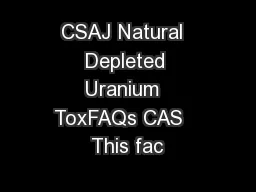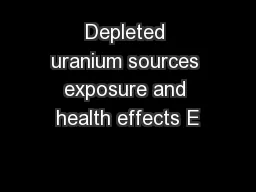PDF-CSAJ Natural Depleted Uranium ToxFAQs CAS This fac
Author : liane-varnes | Published Date : 2015-05-27
For more information call the CDC Information Center at 18002324636 This fact sheet is one in a series of summaries about hazardous substances and their health effects
Presentation Embed Code
Download Presentation
Download Presentation The PPT/PDF document "CSAJ Natural Depleted Uranium ToxFAQs ..." is the property of its rightful owner. Permission is granted to download and print the materials on this website for personal, non-commercial use only, and to display it on your personal computer provided you do not modify the materials and that you retain all copyright notices contained in the materials. By downloading content from our website, you accept the terms of this agreement.
CSAJ Natural Depleted Uranium ToxFAQs CAS This fac: Transcript
Download Rules Of Document
"CSAJ Natural Depleted Uranium ToxFAQs CAS This fac"The content belongs to its owner. You may download and print it for personal use, without modification, and keep all copyright notices. By downloading, you agree to these terms.
Related Documents














